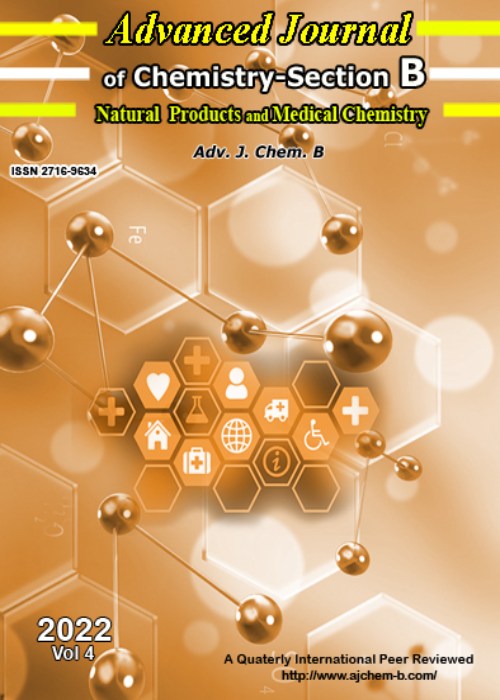فهرست مطالب
Advanced Journal of Chemistry, Section B: Natural Products and Medical Chemistry
Volume:1 Issue: 1, Autumn 2019
- تاریخ انتشار: 1398/09/10
- تعداد عناوین: 7
-
Pages 1-2
Medical catheters come in a variety of sizes for various applications. From Foley catheter, a flexible tube that a clinician passes through the urethra and into the bladder to drain urine, to coronary stent, a tube-shaped device placed in the coronary arteries that supply blood to the heart, to keep the arteries open in the treatment of coronary heart disease, they address medical conditions in different fields, from urology, to cardiology, gastroenterology, gynaecology, and more.
Keywords: Medical catheter, polymer coating, medical device manufacturing -
Pages 3-9Antidepressant activity of curcumin (Cur), as a very well–known herbal product, has been investigated within this work. Two tautomeric forms of Cur–a and Cur–b in addition to the reference structure of Moclobemide (Moc) have been optimized first to evaluate molecular descriptors for ligands. Subsequently, monoamine oxidase–A (MAO–A) has been prepared as receptor for molecular docking (MD) simulation. Interacting systems of ligand–receptor have been very well determined in both of quantitative and qualitative aspects. The results indicated that both of Cur–a and Cur–b are good ligands for interactions with MAO–A even better than Moc, in which Cur–a is more favorable, But based on the interaction of Moc with flavin group of MAO–A, Cur could be employed as a complementary compound for antidepressant activity. All the interacting mechanism of ligand–receptor are very well recognized with this work.Keywords: curcumin, Monoamine oxidase-a, Moclobemide, antidepressant, In Silico
-
Pages 10-16Chelations of neutral and one–electron positive ionic alkali metals including Lithium (Li/Li+), Sodium (Na/Na+) and Potassium (K/K+) by 3–Hydroxy–4–Pyridinone (HPO) have been investigated by the in silico density functional theory (DFT) approach. The investigated single HPO and corresponding complex systems have been first optimized and their properties have been then evaluated for the minimized energy structures. Moreover, the atomic scale quadrupole coupling constant (QCC) properties have been evaluated for further investigations of the optimized complex systems. The results indicated that the neutral/ionic states of alkali metals are important for determining the complex systems in addition to their element types. Moreover, the effects of chelations on molecular orbitals could propose complex systems for different diagnostics activities. The atomic scale properties also indicated that all atoms of complex systems are important for chelation processes. And finally, the HPO structure could be proposed for alkali metal chelation with differential diagnostic activities.Keywords: Pyridinone, Alkali metal, Chelation, DFT
-
Pages 17-22The in silico molecular docking (MD) simulations have been performed to examine the efficacy of three flavonoid ligands including chrysin, apigenin and luteolin on monoamine oxidase–A (MAO–A) enzyme inhibitions in comparison with the reference moclobemide inhibitor. All the obtained quantitative and qualitative results indicated that the flavonoid ligands could be proposed as possible inhibitors for MAO–A enzyme activity. The most important note is that the ligands could interact with the coenzyme of MAO–A, which is dominant for enzyme inhibition. The results indicated that luteolin could be proposed as the best choice of MAO–A enzyme inhibitor among the investigated ligands.Keywords: Flavonoid, Monoamine oxidase–A, In Silico, Molecular docking, depression
-
Pages 23-28The ligand–receptor complex formations between the monoamine oxidase–A (MAO–A) enzyme and its known inhibitors have been examined based on the in silico approach. The conformational structure of each ligand including moclobemide, tranylcypromine, phenelzine and isocarboxazid, has been allowed to relax during Molecular Docking (MD) simulation process. The quantitative binding energy and inhibition constant in addition to the qualitative interacting amino acids and types of interactions indicated that moclobemide and isocarboxazid could be considered for better enzyme inhibition whereas phenelzine could not be proposed for this purpose. Moreover, types of interactions and also number of interacting amino acids showed the favorability of moclobemide and isocarboxazid in comparison with other investigated ligands structures for MAO–A inhibition.Keywords: Moclobemide, Tranylcypromine, Phenelzine, Isocarboxazid, Monoamine oxidase, Inhibition
-
Pages 29-36Density functional theory (DFT) calculations have been performed to investigate the adsorption of hydrogen (H2), nitrogen (N2) and carbon monoxide (CO) diatomic gaseous molecules at the surface of Li+ contained C16B8P8 fullerene-like nanostructure (Li+@C16B8P8). The evaluated results from the optimized structures indicated that the adsorption processes could be taken placed for the interacting gas and fullerene systems. Moreover, the electronic properties indicated that the electrical conductivities of Nano Clusters systems are changed after the adsorption processes, in which it could be a signal for detection or sensing of the existence of the gas in the environment. These changes lead to declining the HOMO/LUMO gap of the Fullerene-Like Nano Cage to its original value. As a finding of this work, it could be mentioned that the Li+@C16B8P8 fullerene-like nano cage could be considered as a suitable adsorbent for the CO, N2 and H2 gaseous. It means that the utilized Li+@C16B8P8 Fullerene-Like Nano Cage can detect the existence of gas in the environment.Keywords: Density functional theory, Adsorption, Fullerene, Sensor, Diatomic gas
-
Pages 37-41The electronic structure properties of the LiBC3 alloy material, which attracts great interest in both lithium-ion batteries and a possibility to use in medical applications, have been studied by means of the theoretical approach with the commercial code FEFF 8.20 in absorption spectroscopy technique. The analysis results revealed that due to the quantum selection rules no strong coupling between neighboring atoms built in the crystal. Moreover, the lithium atoms were determined to weakly bonded to the BC3 system and treated as an isolated ion with easily breakable bonded in a weak excitation process. Due to its rich Li-ion content, the material can be a strong candidate for the lithium-ion battery energy storage devices with possibly powerful intercalation properties. Also, the existence of both boron and carbon in the crystal structure with weakly bonded Li+ ions provides the material a medical potential in drug designs or medical applications that are related to chemical applications.Keywords: Borocarbide, Drug design, Absorption, Li-ion battery


